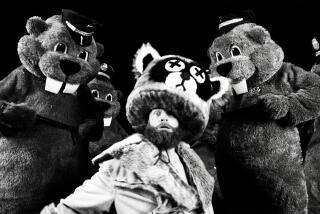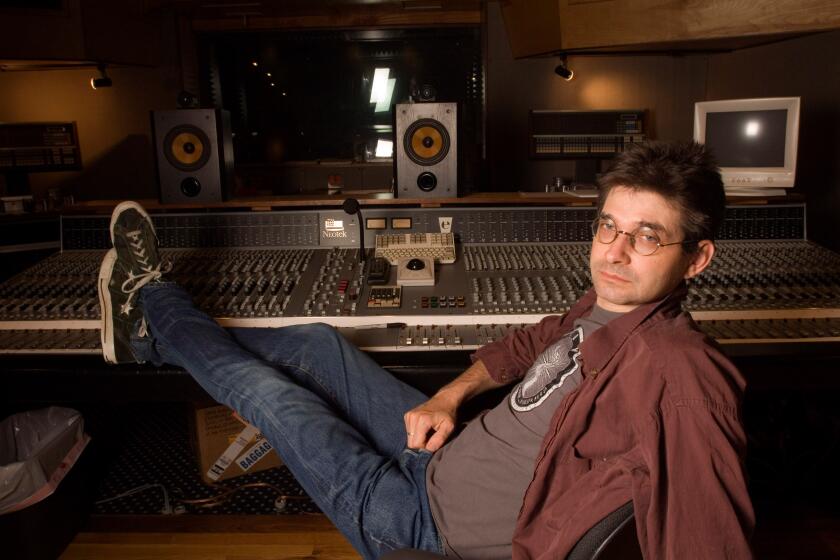Raymond Scott, fave of Bart Simpson, in REDCAT music tribute
Few cultural aficionados today recognize Raymond Scott’s name. But if you’ve ever watched a Looney Tunes cartoon, or an episode of “The Ren & Stimpy Show,” or “The Simpsons,” you’ve likely heard some of his antic, polyrhythmically perverse, one-of-a-kind music.
And if you’re a musical-techno gear geek, you may use state-of-the-art sound-making and noise-processing equipment that Scott, a prolific inventor, helped pioneer in the days of reel-to-reel tape recorders and UNIVAC computers.
On Friday evening, several Scott devotees and fellow musicians, including composer Ego Plum and former Oingo Boingo guitarist Steve Bartek, will pay tribute to the artist with the program “Machine-Man: The Musical Mayhem of Raymond Scott.”
Earlier this week we spoke by phone with Plum, musical director of the 10-piece Ebola Music Orchestra, who has released several albums on his own record label and written music for animated cartoons. Here’s an edited transcript of the conversation.
We think of Scott as almost an outsider artist, but during his heyday his music was smack in the middle of pop culture. His famous tune “The Toy Trumpet,” for instance, was used in the tap-dance finale of the Shirley Temple film “Rebecca of Sunnybrook Farm.” And he had his own ensemble, the Raymond Scott Quintette, which was very popular for a time.
He was part of mainstream American pop culture because of his involvement with the TV show “Your Hit Parade,” being the band director of that. That’s sort of the equivalent of being Paul Schaffer every night on TV. You’d tune in and you’d see Raymond Scott playing the pop tunes of the day, with his wife, Dorothy Collins, singing the songs. So it definitely represented this sort of mainstream thing.
But what happened after he retired from that was he sort of became this recluse, in my opinion, and retired to his laboratory and started building stuff. He had enough money from what he did there and the hits with the Quintette that he just started building electronic machines. And all this material that didn’t surface until 10 years ago when “Manhattan Research” was put out, the double CD. The electronic stuff that came out in, I think, 2000 by Basta Records, what I heard then, it just blew my mind. It sounds like Kraftwerk and like Brian Eno. It’s so experimental and rhythmic, like dance music at times, and from the late ‘50s and early ‘60s.
That explains the allusion in the REDCAT program’s title to “The Man Machine,” Kraftwerk’s landmark 1978 electronica album.
What we’re doing is sort of exploring the duality, really, of Raymond Scott. It’s part man, part machine. And when I approached Steve Bartek last year, I knew that he would be the perfect guy to take on the challenge of interpreting Scott’s jazz stuff. I know it’s beyond my abilities, but I knew that I could take a stab at the electronic stuff and arrange that and put together an ensemble to do that. We’re literally going to split the stage in half. His half on the left, it’s going to be like a jazz band. My side is going to be all electronic equipment, analog synthesizers, computers, iPads. It’s going to be like the past and the future all up on stage at the same time, and that’s essentially Raymond Scott’s head split in half.
Scott made some of the most experimental jazz during a particularly experimental period.
What was unique about his jazz was that he wasn’t a fan of improvisation. At the same time, he wouldn’t want his musicians to use sheet music either. So they had to learn this stuff and memorize it. And they hated him for it! So it swings and it feels like jazz, but it really is all very calculated and he knows exactly what he wants from these guys.
The machines Scott invented are from the analog era, obviously. But are some of them forerunners of machines being used today, or did they belong to a different genus or species?In a way, he invented the sequencer, which is something that is commonly used by everyone that does music today, machines that could remember passages and play them. And he also sort of pre-dated Robert Moog in inventing synthesizers; I think Robert Moog even admitted that when he was alive. But the thing is, Raymond Scott was such a recluse and sort of hidden away in his basement, he wasn’t interested in selling it or putting it out there or marketing it. That was Moog’s genius.
How did this music end up being so associated with cartoons?
That’s because Carl Stalling [a composer and arranger at Warner Bros.] in the ‘30s was able to adapt all of the Raymond Scott music that was in the Warner Bros. catalog to all these cartoons. Plus the fact that Warner Bros. actually owned Raymond Scott’s catalog of music, the Quintette stuff and all that. Raymond never intended for this music to be in cartoons. As animated and crazy as it was, that wasn’t his intention. But Carl Stalling thankfully knew that this would be perfect as the backdrop to Bugs Bunny and Daffy Duck and all these amazing characters that today we sort of associate with Raymond Scott’s music.
And later Ren and Stimpy.
Of course, and “The Simpsons.”
Scott’s music and animation are sort of a match made in heaven, but has it also perhaps inadvertently kept his music from being taken as seriously as it would otherwise be?
The cartoons helped bring Raymond Scott’s music into mass consciousness, but at the same time that is a valid point. And that’s sort of our job, people like me and Steve Bartek and Jeff Winner, who runs the Raymond Scott Archives -- to bring Raymond Scott into the mass consciousness again and relay the importance of his work and let people know that this is a serious, important part of American culture.
ALSO:
Lady Gaga leaks Kendrick Lamar video
Michael Nesmith is channeling ‘Mike the Monkee’ for reunion tour
‘Gossip Girl’ to feature songs from Frank Ocean’s ‘Channel Orange’
Follow me on Twitter: @RJohnsonLAT
PHOTOS AND MORE:
PHOTOS: Iconic rock guitars and their owners
The Envelope: Awards Insider
PHOTOS: Unfortunately timed pop meltdowns
More to Read
The biggest entertainment stories
Get our big stories about Hollywood, film, television, music, arts, culture and more right in your inbox as soon as they publish.
You may occasionally receive promotional content from the Los Angeles Times.







